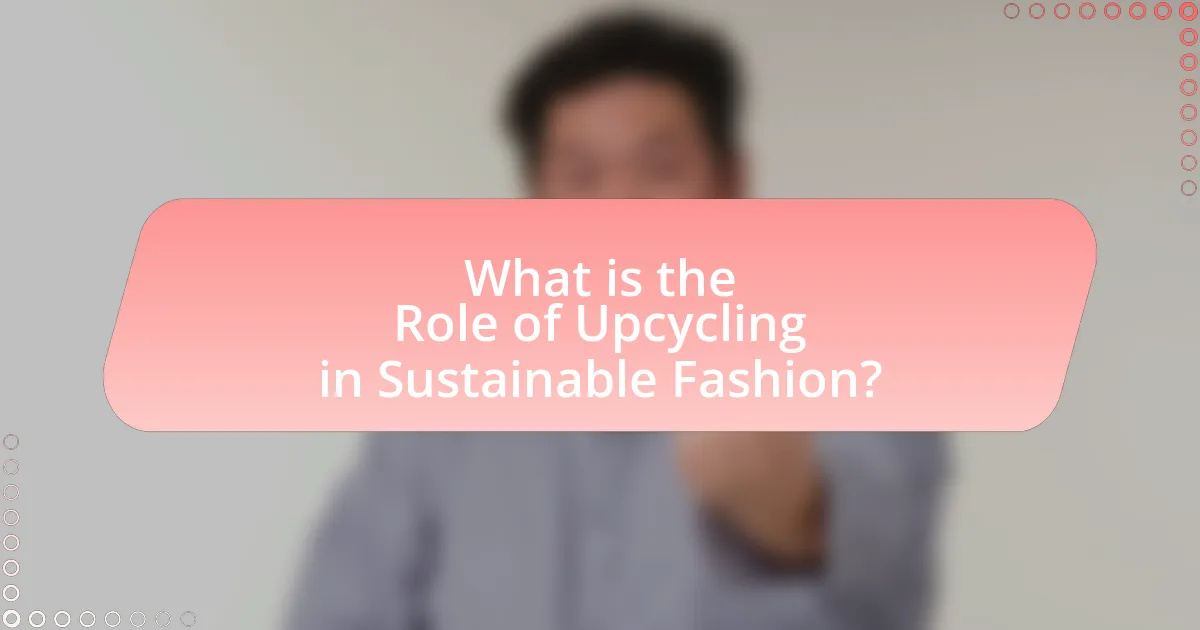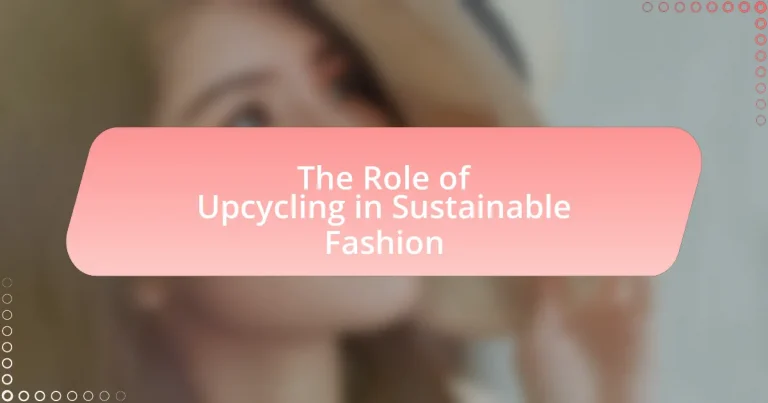Upcycling is a pivotal practice in sustainable fashion, transforming waste materials into new products and significantly reducing environmental impact. The fashion industry generates approximately 92 million tons of textile waste annually, and upcycling addresses this issue by repurposing discarded clothing and materials, promoting a circular economy. This article explores how upcycling contributes to sustainability, the materials commonly used, its influence on consumer behavior, and the challenges it faces in scalability and perception. Additionally, it highlights successful examples and innovative techniques in upcycling, emphasizing the role of technology and craftsmanship in creating high-quality, eco-friendly fashion.

What is the Role of Upcycling in Sustainable Fashion?
Upcycling plays a crucial role in sustainable fashion by transforming waste materials into new products, thereby reducing environmental impact. This practice minimizes textile waste, as approximately 92 million tons of textile waste are generated globally each year, according to the Ellen MacArthur Foundation. By creatively repurposing discarded clothing and materials, upcycling not only conserves resources but also promotes a circular economy, where products are reused and recycled rather than disposed of. Furthermore, upcycling encourages consumer awareness and engagement in sustainable practices, fostering a culture of responsible consumption in the fashion industry.
How does upcycling contribute to sustainability in the fashion industry?
Upcycling contributes to sustainability in the fashion industry by transforming waste materials into new products, thereby reducing the demand for virgin resources. This process minimizes textile waste, as it repurposes discarded clothing and materials that would otherwise end up in landfills. According to a report by the Ellen MacArthur Foundation, the fashion industry is responsible for 92 million tons of waste annually, highlighting the significant impact of upcycling in mitigating this issue. By extending the lifecycle of materials, upcycling not only conserves resources but also decreases carbon emissions associated with production and disposal, making it a vital practice for promoting sustainability in fashion.
What materials are commonly used in upcycling for fashion?
Common materials used in upcycling for fashion include denim, cotton, leather, and various types of textiles such as silk and wool. Denim is frequently repurposed due to its durability and widespread availability, while cotton is often sourced from discarded clothing. Leather is utilized for its longevity and aesthetic appeal, and textiles like silk and wool are chosen for their quality and potential for creative redesign. The practice of upcycling not only reduces waste but also promotes sustainable fashion by giving new life to materials that would otherwise contribute to landfill.
How does upcycling reduce waste in the fashion supply chain?
Upcycling reduces waste in the fashion supply chain by transforming discarded materials into new products, thereby minimizing the need for virgin resources. This process diverts textiles and other materials from landfills, where they would otherwise contribute to environmental degradation. According to a report by the Ellen MacArthur Foundation, the fashion industry is responsible for 92 million tons of waste annually, and upcycling can significantly mitigate this by reusing existing materials. By extending the lifecycle of products, upcycling not only reduces waste but also lowers the carbon footprint associated with manufacturing new items.
Why is upcycling important for the future of fashion?
Upcycling is important for the future of fashion because it reduces waste and promotes sustainability by transforming discarded materials into new products. The fashion industry is one of the largest polluters globally, with an estimated 92 million tons of textile waste generated annually, according to the Ellen MacArthur Foundation. By upcycling, brands can minimize their environmental impact, conserve resources, and encourage a circular economy, where materials are reused rather than discarded. This practice not only addresses the pressing issue of waste but also fosters creativity and innovation within the industry, leading to unique and personalized fashion items that appeal to environmentally conscious consumers.
What environmental impacts does upcycling mitigate?
Upcycling mitigates several environmental impacts, primarily waste generation and resource depletion. By transforming discarded materials into new products, upcycling reduces the volume of waste sent to landfills, which is significant given that the Environmental Protection Agency reported that in 2018, over 292 million tons of municipal solid waste were generated in the U.S. alone. Additionally, upcycling lessens the demand for new raw materials, thereby conserving natural resources and reducing the energy consumption associated with manufacturing processes. For instance, producing recycled materials typically requires less energy than creating new materials from virgin resources, which can lead to lower greenhouse gas emissions.
How does upcycling influence consumer behavior towards sustainability?
Upcycling significantly influences consumer behavior towards sustainability by promoting a mindset that values resourcefulness and environmental responsibility. This practice encourages consumers to view waste materials as valuable resources, leading to increased awareness of the environmental impact of their purchasing decisions. Research indicates that consumers who engage with upcycled products are more likely to adopt sustainable practices, as they recognize the benefits of reducing waste and conserving resources. For instance, a study published in the Journal of Cleaner Production found that consumers exposed to upcycled products reported higher levels of environmental concern and a greater intention to purchase sustainable goods. This shift in behavior reflects a broader trend where upcycling not only enhances the appeal of sustainable fashion but also fosters a culture of sustainability among consumers.
What challenges does upcycling face in the fashion industry?
Upcycling in the fashion industry faces several significant challenges, including scalability, consumer perception, and supply chain limitations. Scalability is a major issue as upcycling often relies on small-scale operations that struggle to meet high demand, limiting its widespread adoption. Consumer perception also poses a challenge; many consumers associate upcycled products with lower quality or lack of style, which can hinder market acceptance. Additionally, supply chain limitations arise from the inconsistent availability of materials suitable for upcycling, making it difficult for brands to maintain a steady production flow. These challenges collectively impede the growth and integration of upcycling within the broader fashion industry.
What are the limitations of upcycling in terms of scalability?
Upcycling faces significant limitations in scalability due to the reliance on manual labor and the variability of available materials. The process often requires skilled artisans to transform waste into new products, which can restrict mass production capabilities. Additionally, the inconsistent quality and quantity of materials sourced for upcycling can hinder the ability to produce items at scale. For instance, a study by the Ellen MacArthur Foundation highlights that while upcycling can reduce waste, it often lacks the efficiency and uniformity needed for large-scale manufacturing, making it less viable for widespread adoption in the fashion industry.
How do perceptions of quality affect upcycled fashion products?
Perceptions of quality significantly influence consumer acceptance and purchasing decisions regarding upcycled fashion products. When consumers view upcycled items as high-quality, they are more likely to embrace them, leading to increased sales and brand loyalty. Research indicates that consumers often associate quality with durability and aesthetic appeal; thus, if upcycled products are perceived as well-made and stylish, they can compete effectively with traditional fashion items. For instance, a study published in the Journal of Fashion Marketing and Management found that perceived quality directly correlates with consumers’ willingness to pay a premium for sustainable products, including upcycled fashion. This demonstrates that positive perceptions of quality can enhance the marketability and success of upcycled fashion initiatives.
How can upcycling be integrated into mainstream fashion practices?
Upcycling can be integrated into mainstream fashion practices by incorporating it into design processes, supply chains, and consumer education. Fashion brands can adopt upcycling by redesigning existing garments or materials into new products, which reduces waste and resource consumption. For instance, brands like Reformation and Patagonia have successfully implemented upcycling strategies, showcasing collections made from surplus fabrics and recycled materials. This approach not only promotes sustainability but also appeals to environmentally conscious consumers, as evidenced by a 2021 McKinsey report indicating that 67% of consumers consider sustainability when making a purchase. By prioritizing upcycling, the fashion industry can significantly reduce its environmental impact while meeting the growing demand for sustainable practices.
What innovative techniques are being used in upcycling fashion?
Innovative techniques in upcycling fashion include the use of digital printing, laser cutting, and patchwork. Digital printing allows designers to create unique patterns on existing fabrics, transforming them into one-of-a-kind pieces. Laser cutting enables precise alterations and intricate designs, enhancing the aesthetic appeal of upcycled garments. Patchwork techniques combine various fabric scraps, promoting creativity and reducing waste. These methods not only contribute to sustainability but also foster individuality in fashion, as seen in collections by brands like Reformation and Eileen Fisher, which emphasize eco-friendly practices and innovative design.
How do designers incorporate upcycled materials into their collections?
Designers incorporate upcycled materials into their collections by creatively reusing discarded textiles and other materials to create new garments and accessories. This practice not only reduces waste but also promotes sustainability in fashion. For example, brands like Reformation and Patagonia utilize surplus fabrics and vintage clothing, transforming them into stylish, modern pieces. According to a report by the Ellen MacArthur Foundation, upcycling can significantly decrease the environmental impact of fashion by extending the lifecycle of materials, thereby reducing the demand for new resources.
What role do technology and craftsmanship play in upcycling?
Technology and craftsmanship are essential in upcycling as they enhance the efficiency and creativity of transforming waste materials into valuable products. Technology facilitates innovative processes, such as digital design tools and automated cutting machines, which streamline production and reduce material waste. For instance, the use of 3D printing technology allows designers to create intricate designs from recycled materials, minimizing the need for new resources. Meanwhile, craftsmanship ensures that the final products maintain high quality and aesthetic appeal, as skilled artisans apply their expertise to refine and personalize upcycled items. This combination of advanced technology and traditional skills not only promotes sustainability but also fosters unique, high-quality fashion pieces that resonate with consumers seeking eco-friendly alternatives.
What are some successful examples of upcycling in fashion?
Successful examples of upcycling in fashion include brands like Re/Done, which transforms vintage Levi’s jeans into modern styles, and Patagonia, known for its Worn Wear program that repairs and resells used clothing. Re/Done has gained popularity for its unique approach, with sales exceeding $10 million in 2018, demonstrating consumer demand for upcycled products. Patagonia’s initiative not only extends the life of garments but also promotes sustainability, with over 45,000 items repaired through Worn Wear in 2020, showcasing the effectiveness of upcycling in reducing waste and encouraging responsible consumption.
Which brands are leading the way in upcycled fashion initiatives?
Patagonia, Reformation, and Eileen Fisher are leading brands in upcycled fashion initiatives. Patagonia has implemented its Worn Wear program, which encourages customers to repair and recycle their gear, significantly reducing waste. Reformation focuses on using deadstock fabrics and has launched a collection made entirely from upcycled materials, promoting sustainability in its production processes. Eileen Fisher’s Renew program takes back worn clothing to be remade into new designs, emphasizing circular fashion. These brands exemplify commitment to sustainability through innovative upcycling practices.
How have collaborations enhanced upcycling efforts in the industry?
Collaborations have significantly enhanced upcycling efforts in the industry by pooling resources, expertise, and creativity from diverse stakeholders. For instance, partnerships between fashion brands and non-profit organizations have led to innovative upcycling projects that transform waste materials into new products, thereby reducing environmental impact. A notable example is the collaboration between Adidas and Parley for the Oceans, which repurposes ocean plastic into footwear, demonstrating how joint efforts can effectively address sustainability challenges. Such collaborations not only amplify the reach and impact of upcycling initiatives but also foster a culture of sustainability within the industry, encouraging more brands to adopt similar practices.
What practical tips can consumers follow to support upcycling in fashion?
Consumers can support upcycling in fashion by choosing to buy second-hand clothing and accessories, which reduces waste and encourages the reuse of materials. By shopping at thrift stores, vintage shops, or online resale platforms, consumers help extend the lifecycle of garments, thereby minimizing the demand for new production. Additionally, consumers can engage in DIY projects to transform old clothing into new items, fostering creativity and personal expression while reducing textile waste. According to the Ellen MacArthur Foundation, extending the life of clothing by just nine months can reduce carbon, water, and waste footprints by around 20-30%. This demonstrates that consumer choices directly impact sustainability in the fashion industry.


